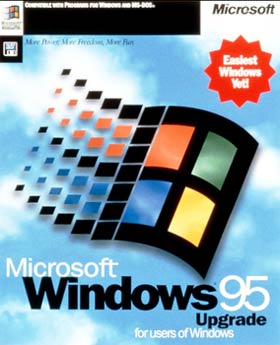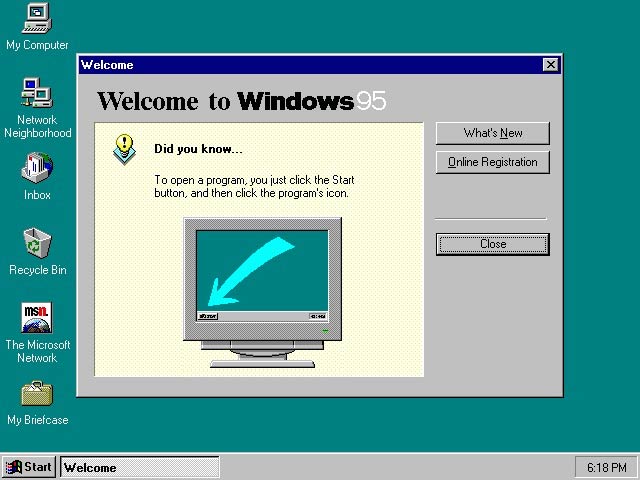 It’s been 20 years since the launch of Microsoft’s Windows 95 operating system, which changed the way we interacted with computers. But what was it that was so special about the software, and why all the upgrades over the years?
It’s been 20 years since the launch of Microsoft’s Windows 95 operating system, which changed the way we interacted with computers. But what was it that was so special about the software, and why all the upgrades over the years?
Windows 95 was Microsoft’s big push into the world of graphical user interfaces. Previous versions of Windows required users to provide input predominantly by using the keyboard, with a mouse click only here and there. Windows 95 introduced Microsoft users to a world where everything was “point and click”, with the mouse used as much as possible and the keyboard only used where necessary.
It’s been argued that the free games packed with Windows 95 — Solitaire, Minesweeper (a favourite of Bill Gates), Hearts or FreeCell — were all designed to teach us how to use the mouse for click, drag and drop actions.
The Windows 95 screen was composed of a number of icons and other images, rather than a collection of text windows. Documents could now be edited by highlighting words with a mouse, and clicking to cut or paste.
Opening, copying and saving files could now also be performed by pointing and clicking. This made everyday computing tasks more intuitive and more efficient to perform, and users of the system responded favourably to it.
The battle with Apple
For Apple users, this appeared to be nothing particularly new. Since the launch of the Macintosh in 1984, Apple had been providing interfaces with similar functionality.
From the perspective of 20 years later, it seems natural that Microsoft would seek to overcome a perceived technological advantage in favour of its main competitor by introducing a similar development of its own.
This was no simple effort though. Graphical user interfaces, particularly for an operating system, require significantly more storage and processing power than text-based ones. Storing images takes vastly more space than text.
A simple task such as opening a file by clicking on an icon requires display monitors that can show sufficient detail, which in turn requires greater processing power. This means that a “point and click” system is only possible with a particular level of hardware development. Accordingly, Windows 95 (or in fact any version of any operating system) can be considered as a showcase for what can be done with the hardware of the time.
Users took to Windows 95 quite quickly. And as with many technological developments, the success of the system led to raised expectations, so that graphical interfaces became the norm and anything less became unthinkable.
The need for upgrades
Had technology and user expectations remained static, we might still be using Window 95 today. But developments in microprocessors, storage and networking inevitably led to an expanded variety and range of applications.
This in turn raised user expectations to new levels, and drove expansion into previously unexplored territory. This means it’s unlikely that any operating system will ever be the final word, but rather will be one more step in a never-ending chain of development.
It is easy to forget how different today’s computer use is from that of 1995. Perhaps it is an accident of history that Windows 95 coincided with the rise of the Internet, but its use at that time was primitive by today’s standards.

This was a time before Facebook (founded in 2004), Twitter (founded in 2006) or other social networks. Internet banking was still at least a decade away. Mobile phones (large and cumbersome by today’s standards) were not ubiquitous, and were used mainly for making phone calls (how novel).
Wireless Internet connections were still a long way away. Larry Page and Sergey Brin met at Stanford in 1995 but it would be a couple of years before they even register google.com. Internet use typically meant sending and receiving electronic mail, or perhaps exploring the brave new world of the World Wide Web using the Mosaic browser (but without the benefits of search engines).
Connection to the Internet at home was chiefly by dial-up modems, which meant that many fledging websites were largely text, as if there were too many images, it would take too long to download them.
The idea that photos, let along videos, would be routinely exchanged over the Internet sounded like science fiction (particularly as photographs were still typically taken on film-based cameras rather than digital ones).
The game-changing nature of the Internet meant that computing became an increasingly important part of everyday life. This made it inevitable that Windows 95 would need to be upgraded with in a few years.
Through the next Windows
And that’s how it’s been over the past 20 years. The twin pressures of technological innovation and expanding applications have ensured that there have been several new versions of Windows since 1995 (some of which, it must be said, were more memorable than others).
It is now unremarkable to upload videos to sites such as Facebook, or to pause an online movie playing on a laptop in order to pay bills online, tasks that were a pipe dream when Windows 95 was launched.
A further driver for change, which is largely invisible to the average user, is that a typical computer now contains multiple processors. This increases the processing power of the machine, but significantly complicates the architecture of the operating system, which needs to be able to exploit this extra capability while still remaining simple to use for the average person.
Annoying as it may have been to upgrade from say Windows 98 to Windows XP, sometimes upgrading to a new version of the operating system is simply the price of progress.
Windows 10 is still in its infancy, but so far it seems to have the hit the mark. It may not have to deal with floppy drives or dial-up modems, but there is still a lot more going on under the hood than in the days of Windows 95 all those years ago.![]()
- James Harland is associate professor in computational logic at RMIT University
- This article was originally published on The Conversation

